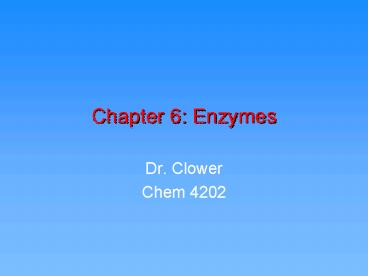Chapter 6: Enzymes - PowerPoint PPT Presentation
1 / 38
Title:
Chapter 6: Enzymes
Description:
Active site alters shape to maximize intermolecular attractions. O. H. H3N. O. O. O ... Coming up next... Enzyme kinetics and inhibition. section 6.3. Enzyme ... – PowerPoint PPT presentation
Number of Views:82
Avg rating:3.0/5.0
Title: Chapter 6: Enzymes
1
Chapter 6 Enzymes
- Dr. Clower
- Chem 4202
2
Part 1 Enzymatic Catalysis
- Sections 6.1, 6.2, 6.4
- What is an enzyme?
- What is a catalyst?
- Mechanisms of enzyme catalysis
- Examples
3
What is an enzyme?
- Globular proteins acting as the bodys catalysts
- Nomenclature
- Root ase
- Classification
- Oxidoreductases
- Transferases
- Hydrolases
- Lyases
- Isomerases
- Ligases/synthetases
- E.C. Numbers
4
What is a catalyst?
- Speed up time for reaction to reach equilibrium
- Lowers activation energy
5
Enzymes as Catalysts
6
Methods of catalysis
- Provide a reaction surface/suitable environment
- Bring reactants together
- Position reactants correctly for reaction
- Weaken bonds in the reactants
CH2
H
H
H
H
CH2
Metal
7
Enzymes as catalysts
- Provide a reaction surface (the active site)
- Provide a suitable environment (hydrophobic)
- Bring reactants together
- Position reactants correctly for reaction
- Weaken bonds in the reactants
- Provide acid / base catalysis
- Provide nucleophiles
8
An example reaction
- Reduction of pyruvate to lactate
- Homolactic fermentation
- LDH Lactate dehydrogenase (enzyme)
- NADH reducing agent coenzyme
- Pyruvic acid substrate
9
The active site
- Hydrophobic hollow or groove on the enzyme
surface - Accepts reactants (substrates and coenzymes)
- Contains amino acids which
- bind reactants (substrates and coenzymes)
- catalyze the reaction
chymotrpysin
10
Cofactors/Coenzymes
11
Enzyme catalysis
- Binding interactions
- strong enough to hold the substrate sufficiently
long for the reaction to occur - weak enough to allow the product to depart
- Drug design
- designing molecules with stronger binding
interactions results in enzyme inhibitors which
block the active site
12
Substrate binding bonding forces
- Ionic
- H-bonding
- Hydrophobic
13
Binding of pyruvic acid in LDH
14
Substrate binding induced fit
- Active site is nearly the correct shape for the
substrate - Binding alters the shape of the enzyme (induced
fit) - Binding will strain bonds in the substrate
Induced fit
15
Induced Fit
- Hexokinase
16
Induced fit
- Active site alters shape to maximize
intermolecular attractions
- Intermolecular bonds not optimum length for
maximum bonding
- Intermolecular bond lengths optimized
- Susceptible bonds in substrate strained
- Susceptible bonds in substrate more easily broken
17
Binding of pyruvic acid in LDH
O
H
H3N
18
Binding of pyruvic acid in LDH
O
H
H3N
19
Enzymes are Stereospecific
- Asymmetrical Synthesis
20
Catalysis Mechanisms
- Acid-Base
- Covalent
- Metal Ion
- Electrostatic
- Proximity and Orientation Effects
- Preferential TS Binding
21
Acid-Base Catalysis
- Proton-transfer reaction stabilize TS
- Example
- Enzymes as acids/bases
Non-ionized Acts as a basic catalyst (proton
'sink')
Ionized Acts as an acid catalyst (proton source)
22
Acid-base Catalysis
- What happens if both acid and base are present?
- Solution
- Enzyme
23
Covalent Catalysis
- aka Nucleophilic Catalysis
24
(No Transcript)
25
Metal Ion Catalysis
- Metalloenzymes
- Metal-activated enzymes
- How do metal ions participate in the catalytic
process? - Orient substrates
- Redox
- Facilitate formation of hydroxide ion
- Electrostatic stabilization
26
Electrostatic Catalysis
- Exclusion of water from active site
- Increases polarity
- Strong electrostatic interactions
- Stabilize TS
- Ion channel
27
Proximity and Orientation Effects
- Reactants must come together with the proper
spatial relationship for a reaction to occur - Enzymes
- Bring substrates into contact with catalytic
groups and/or each other - Bind substrates in proper orientation for
reaction - Restrict rotational motion of substrates so align
reactive portions of molecules
28
Proximity and Orientation Effects
- Compare reactions of imidazole with a carbonyl
- Intermolecular
- Intramolecular
29
Preferential TS Binding
- Enzymes stabilize TS
- Increase formation of TS
- Typically bind TS better than either reactant or
product - Induced fit can distort bond lengths/angles
30
An example Lysozyme
- Bactericidal agent
- Destroy cell walls
- Hydrolyze glycosidic linkages in cell wall
peptidoglycans - Alternating NAG and NAM
- Peptidoglycan N-acetylmuramoylhydrolase
31
Hen Egg White Lysozyme
- Most widely studied/understood species
- Single polypeptide
- 129 AA residues, 5 a-helices, 1 b-sheet, 4
disulfide bonds - Roughly ellipsoidal
- Cleft across one side active binding site
32
Substrate
- 6 saccharide residues
- - NAG-NAM-NAG-NAM-NAG-NAM
- D distorts to half-chair to avoid steric strain
and maximize H-bonding - D-E b1?4 glycosidic bond cleaves
33
Mechanism
34
(No Transcript)
35
(No Transcript)
36
(No Transcript)
37
Other examples
- Hexokinase
- Enolase
- Serine proteases (chymotrypsin)
- See your textbook section 6.4
38
Coming up next
- Enzyme kinetics and inhibition
- section 6.3
- Enzyme regulation
- section 6.5































